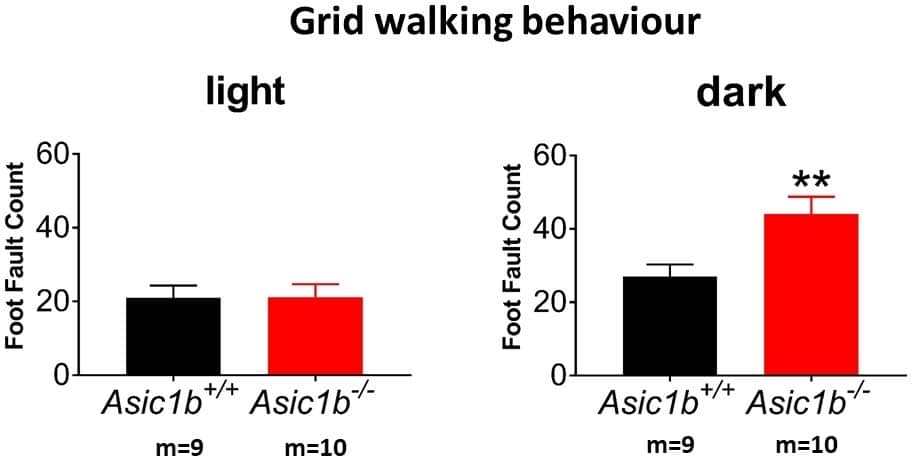Amiloride-sensitive ion channels (ASICs) are highly expressed in primary mechanosensory nerve endings, including muscle spindle primary endings and baroreceptors monitoring blood pressure. However, their role there is unclear. Indeed, their possible role in neurosensory mechanotransduction is disputed1,2,3. Nevertheless, they are one of the few putative mechanosensory channel families that display amiloride sensitivity and a selective conductance for Na+, characteristics of the mechanosensory receptor potential in muscle spindles4,5. We have shown that ASIC1b is selectively expressed in primary mechanosensory terminals3. We therefore examined the effect of ASIC1b deletion on blood pressure and fine motor control in vivo, plus muscle spindle mechanosensory responses ex vivo. Experiments were covered by relevant national and local animal experimentation ethical approvals. Characterization of ASIC1b-expressing neurones was performed by immunofluorescence staining. Blood pressure was measured using a tail cuff, after 5 days habituation, and motor skills by hind foot placement faults during grid walking. Soleus nerve-muscle preparations were removed after humane killing (Schedule 1, Animals (Scientific Procedures) Act, 1986). The number of action potentials (APs) in the muscle nerve during hold phase of stretch-hold-release (ramp) profiles was quantified, as was the firing in amiloride, a broad-spectrum blocker of ASICs. Data are expressed as mean±SEM, from ‘n’ muscles and ‘m’ mice, and WT vs KO. The significance of differences was ascertained by ANOVA or t-test as appropriate, with a P=0.05 threshold. ASIC1b-expressing neurones represented ~40% of NF200 positive (large myelinated), ~35% of peripherin positive (non-/poorly-myelinated) and ~47% of IB4 positive (nonpeptidergic), but only ~3.5% CGRP positive (peptidergic) neurones. ASIC1b-/- mice had significantly lower systolic (105.5±6.0 vs 88.5±4.4 mmHg; P<0.02, m=5/group) but not diastolic (84.7±41 vs 76.8±4.3 mmHg; P=0.18, m=5/group) blood pressure. They also displayed higher foot faults during grid walking without visual or whisker cues (hind foot faults per 5 min: 27.0±3.3, m=9 vs 44.1±4.7, m=10; P<0.01, t-test). Mean hold phase spindle afferent firing rate was greater in WT than ASIC1b-/- mice (124.3±16.7 vs 90.8±15.8 APs/sec), but the difference was not significant (P=0.3, n=26, m=21). Interestingly, while amiloride inhibited hold-phase firing in WT (0.1 mM: 92.3±5.3% initial, n=5, m=4; 1 mM: 61.9±8.0% initial, n=5, m=4) amiloride increased firing in ASIC1b-/- spindles (0.1 mM: 131.7±13.4% initial P<0.01; 1 mM: 125.8±13.9% initial, P<0.001, both n=5, m=5; data normalised to final control value before amiloride addition). We conclude that ASIC1b is a molecular determinant contributing to fine-tuning mechanosensitivity firing rates in proprioceptors.
Physiology 2019 (Aberdeen, UK) (2019) Proc Physiol Soc 43, C103
Oral Communications: ASICs in mechanosensation: ASIC1b deletion in mice reduces blood pressure, perturbs fine motor control in vivo, and reverses amiloride sensitivity of muscle spindle afferent firing.
G. S. Bewick1, C. Lee4, A. T. Leeson-Payne2, J. Rochford2, C. Chen4, R. W. Banks3
1. Institute of Medical Sciences, University of Aberdeen, Aberdeen, Scotland, United Kingdom. 2. The Rowett Institute, University of Aberdeen, Aberdeen, Scotland, United Kingdom. 3. Department of Biosciences, University of Durham, Durham, United Kingdom. 4. Institute of Biomedical Sciences, Academia Sinica, Taipei, Taiwan.
View other abstracts by:
ASIC1b KO greatly increases foot placement errors in grid walking task. Mean � SEM, m (no. of mice). ** P<0.01, t-test.
Where applicable, experiments conform with Society ethical requirements.

